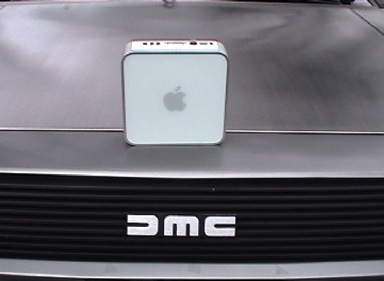DeLorean Mac Mini


“If you’re going to build a computer into a car, why not do it with some style?”
I have always wanted to put a Macintosh-based computer into my DeLorean. Today, you can read about how I made that a reality. This project involved more than just a carputer. This is the merging of an automotive environment and a computing environment. This creates a portable office in your DeLorean. Not just a drive-in movie theater, but a drivable drive-in movie theater. Sound like fun? It is, but challenges along the way have made this ambitious project push the limits on my electronic and fabrication talents.
As soon as the Mac Mini came out, there was a surge in custom car computing. Sites such as MacVroom.com and 123MacMini.com popped up, describing how the compact design and brilliant feature set of the Mac Mini would be ideal for installation in a car. To facilitate this trend, a company called Carnetix designed an intelligent DC-DC regulator to safely power a Mac Mini from a 12-Volt supply. Custom automotive and stereo shops began offering carputer installations to customers.
There was just one aspect of the installs I saw online that was not up to my standards. Most car-computing enthusiasts have installed 7” touchscreens from Lilliput or Xenarc. These are great devices, but I simply refuse to compute on any screen that does less than 1024x768. I tried computing on my big screen TV for a while, and it’s just not healthy. If I design a computer into a car, the screen needs to be at least 20 inches wide, or it’s not worth the effort. I was able to stretch my screen to 37” diagonal.
At this point I was reminded of the fact that it is dangerous for anyone to use a computer while on the road. If I were to install a computer in my car, I told myself I would only use it while parked, to brainstorm ideas or check email in a parking lot, or for display purposes at a car show.
At one such car show with my DeLorean, I had left the DeLorean bonnet open to pack away those folding chairs, and I hopped into the driver’s seat to turn off the stereo. I looked through my windshield at the underside of the bonnet door: a flat, black carpeted surface that spanned most of the viewable area beyond the windshield. This, I told myself, is where I want my computer screen.
Everyone who does carputer integrations knows this is some really cutting edge shit. Computers for the most part were not designed for automotive applications, and cars were not designed to accommodate plug-and-play Mac Minis. Using the Carnetix Kit, for example, requires you to bastardize a brand-new Apple Power supply - just for that proprietary connector - and have the soldering skills to meld a 26 gauge wire without melting it. Most people just don’t have the tools or the patience for such a job.
As a result, there are a certain number of engineering challenges to overcome. For example, how do you access the Mac Mini Boot button on the back of the computer? How do you reliably power the Mac Mini? Where and how do you run that mess of A/V cables that the car just wasn’t designed for? And how do you really get a decent sized screen?
Most Carputers nowadays have a 7” screen from either Liliput or Xenarc. But I feel that running an Apple Environment on a 7” screen at less than 640x480 might be convenient, but doesn’t do Aqua the proper justice. This is why I chose to pursue another method of imaging: projection. Video projectors are becoming mainstream and the costs have come down, making a dedicated video projector in your vehicle a feasible idea. The DeLorean Mac Mini has a 37 inch screen.
********** Ryan Brandys In His Lab at Branmuffin Industries *************


